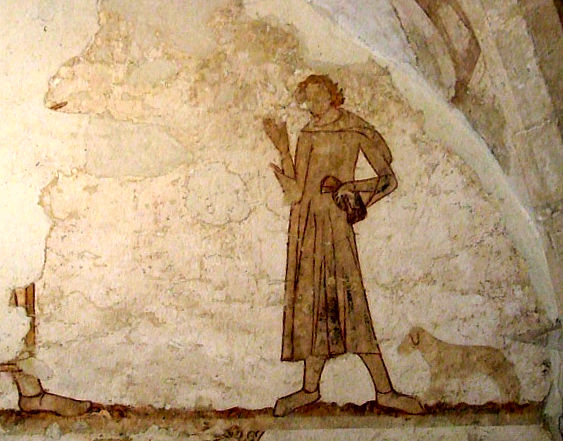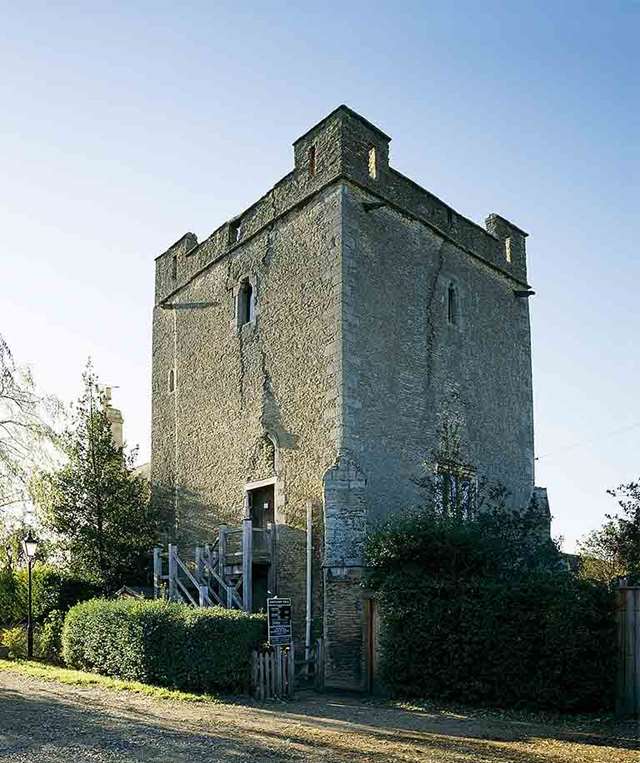Longthorpe Tower, Peterborough, Cambridgeshire c.1310
The East Wall

This is the wall with the entrance door to the Great (or Painted) Chamber at Longthorpe Tower, and this is the painting in the upper tier. It shows a young man, probably a young aristocrat, carefully holding his fashionable gloves, and accompanied by his (now rather faint) dog at the far right.
He raises his right hand, perhaps in salutation of another man, now reduced to one shoe and a few fragments, at the left of the photograph. If there was anything in the centre of the scene it has been lost irretrievably.
My own feeling (it is no more than that) was that this originally showed a pair of young men, one perhaps the servant of the other) about to set out hunting – that favourite aristocratic pastime.
The remains of a large curving banner arc across the top of this photograph. That, too, may have told us more, but the rest is long gone.
Below this tier is one of the most intriguing scenes in the Chamber, the unique Wheel of the Five Senses, shown in the photograph below right.
"God created as many different kinds of things as he did creatures, so that there is no creature which does not differ in some respect from all other creatures, and by which it is in some respect superior or inferior to the rest…" Sir John Fortescue, 15th-century jurist

King Reason, crowned, stands at the centre, his left hand controlling the wheel.¹ Medieval belief insisted that all our God-given human senses should be controlled by Reason – otherwise we are no more rational than ‘beast(s) that want discourse of reason’.¹
Around the wheel, reading from the top left, are symbolic representatives of the bestial world – a spider's web (touch – generally thought of as the ‘lowest’ of the senses), a vulture (sight – as in 'eyes like a hawk'), taste – a monkey holding a piece of fruit, a cockerel (sound, ability to give voice – cockerels crow at dawn), and a boar – hearing, (the wild boar had poor eyesight but exceptionally acute hearing.) And some schools of medieval thought reckoned hearing to be the ‘highest’ sense, above even sight. Wild boar were hunted to extinction in medieval England, nevertheless. They have very recently made a precarious return.
Something else may once have been at the bottom of this scene, below King Reason’s feet. A devil? – possible but very, very, unlikely. Or (much more likely, I think) a mineral, a stone of some kind, representing the very nadir of created nature – silent, voiceless, incapable of motion, thought, feeling, sensation, entirely inert. But even stones excel in durability, as Tillyard pointed out (op. cit. p89), and all remain part of the Great Chain of Being.
The more general point to be made here is that while virtually every animal surpasses Man in one sense-perception or another, none does so in every one. Provided, of course, that ‘King Reason’ is not displaced.
There are one or two more tantalising details around and outside the wheel. At the upper right are traces of two more animals, one above the other. These, I suspect, are entirely non-symbolic dogs – hunting dogs or hounds. At the upper left of the wheel are faint traces of harness – probably the remains of a painted horse. With its double storey and its battlemented parapet walk giving extensive views over the Nene valley, Longthorpe Tower was, among other things, a hunting tower.
Longthorpe is administered by English Heritage. Photography is permitted, and be careful on that external staircase.

¹Hamlet, Act 1, Scene 1, l.150
² The best introductory source for this kind of background information is probably still The Elizabethan World Picture, EMW Tillyard, Pelican Books.
³An excellent guidebook, with photographs, plans, and text by the late E Clive Rouse, is available quite cheaply from from the tower itself. Link at the top of this page.